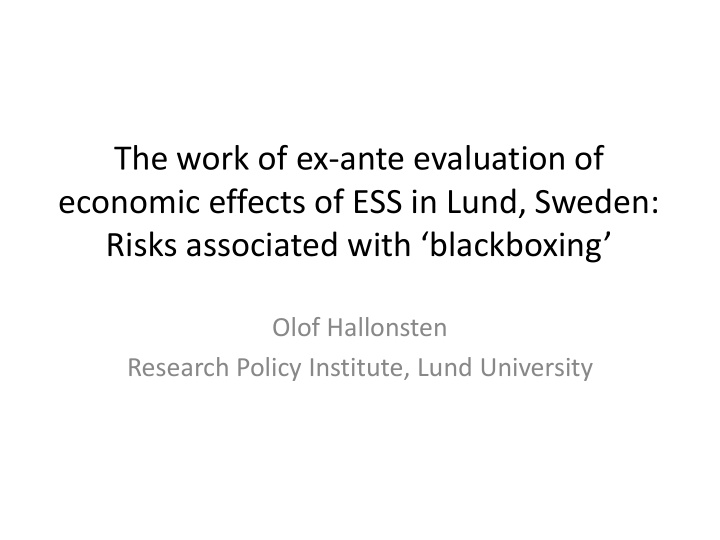



The work of ex-ante evaluation of economic effects of ESS in Lund, Sweden: Risks associated with ‘blackboxing’ Olof Hallonsten Research Policy Institute, Lund University
Short presentation • Sociologist of science. • PhD in research policy (2009) – Thesis Small science on big machines about the historical development of synchrotron radiation in political and scientific context; 3 cases: MAX-lab, ESRF, SSRL at SLAC • Current activities: – Institutional transformation of DESY and SLAC – Research organization in academia in Sweden – Study of big science in the 20 th century – Ex-ante evaluation of socio-economic impacts of ESS • Research Policy Institute, Lund University; Dept for Theory of Science, University of Gothenburg; Dept of Sociology, Wuppertal University
The ESS project • Neutron spallation source, currently with a long pulse target station • Idea over 20 years old: – Early 1990s: first initiatives, ESS council in 1993 – 1999: OECD ’ recommendation ’ (SNS, J -Parc, ESS) – 2002: Bonn conference, no decision – 2003-2009: Sweden, Spain, Hungary contenders – 2009: ’Decision’ in favor of Lund
ESS: anomaly in Sweden, problem child in Europe • Europe: – No decision yet (after 20 years!) – Big countries have withdrawn, nobody has pledged definitive financial support – Dead 2002 but incorporated in ESFRI plans • Sweden: – Political project, weak scientific support – Never scientifically evaluated, never properly anchored (Comparison: MAX IV) – Presented to public and policymakers as ”a laboratory from heaven ” – Swedish unpreparedness
The Politics of European scientific collaboration: conditions • No precedent (external to EC/EU) • Ad hoc agreements • Closed doors negotiations, horse-trading • Mirrors of big politics – CERN and reconstruction – ILL, ESO and the France-Britain strains – ESRF and the France-German unity – XFEL and German-Russian complications
The Politics of European scientific collaboration: trouble • Who will pay and how much? – British, Italian imbalance in ESRF, “perverted mechanism” in XFEL of small countries paying little • Site-selection – CERN II issue 1967-1972 – ESRF and Wind Tunnel agreement: Köln/Strasbourg/Grenoble – Exceptions: ESO, ILL, XFEL (funding issues) • Fair return and in-kind contributions • Scientific fair return? • Result: Structural inertia and political lock-ins
What is the problem? • Improper understanding of scientific , technological and political details • Blackboxing • Examples: – Intensity boost? 5 MW? – Need for neutrons? – Boon to Swedish science? • Focus here: economic impacts. • Politics, science, technology fundamentally important to assessments of future economic benefits
PriceWaterhouseCoopers (2009): The ESS in Lund – its effects on regional development 147 pages, versions in English and Swedish Commissioned and funded by the Regional Council (with co-financing from EU structural fund)
Promises • 0.08 per cent higher GRP/year = € 1.6 billion higher GRP by 2040 • An increase in the number of jobs by 700/year = 23,000 more jobs by 2040 • “ For every million we put in, we will get eight or nine back ” (Allan Larsson, chief negotiator for Sweden, on Swedish national public radio, September 25, 2009) • GRP of Skåne region “is expected to grow with 214 billon SEK, or perhaps even as much as 302 billion SEK, until 2040” (Local daily Sydsvenska Dagbladet, January 14, 2009)
What lies behind? • Blackboxing of the facility project – Scientific: What will it do? – Technological: How is it constructed? – Political: Who will pay and how? • Failure to account for the specifics of the Swedish research system • Expectations
This last year … Reports on education demands and competence in the region, business opportunities, and the need for support structures in the surrounding innovation system
What we have done • Serious background information, case studies, nuances and problematizations • There are no free lunches! • Important distinctions: – direct/indirect – long-term/short-term – Traditional (basic) science focus / envisioned innovation capacity
Un-blackboxing • Scientific and technological fundamentals – Function and purpose of ESS – Frontier science and technology: challenges – Contingency and serendipity • Political reality (Sweden and Europe) – Sweden’s lack of precedent (unpreparedness?) – Europe’s historical quandaries • Innovation system and knowledge economy – Nothing comes for free
Results • Challenges: – Supply-driven innovation capacity (basic science, path dependence) – Political framework (shares, fair return, in-kind contributions) – Taking things for granted • Policy recommendations: – Adequate financing: Securing funds for renewal of experimental equipment (cf. ESRF) – Mandate to work with industry (political framework) – Regional effort: ESS cannot do this themselves
But the black box is still there • Still overly optimistic sentiment • Widespread lack of nuance and elementary understanding • Still no deal • Tremendous challenges ahead for Swedish science
Recommend
More recommend